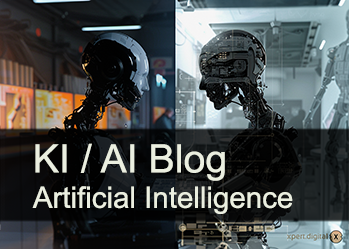Workslop in productivity: AI projects do not bring measurable returns to 95% of companies and how they (must) avoid it
Xpert pre-release
Language selection 📢
Published on: September 26, 2025 / Updated on: September 26, 2025 – Author: Konrad Wolfenstein

Workslop in productivity: AI projects do not bring measurable returns to 95% of companies and how they (must) avoid it – Image: Xpert.Digital
When the use of enterprise AI becomes the only option: Industry-specific AI solutions as a competitive advantage
Important to know! The paradox of artificial intelligence: Why billions of dollars invested in companies fizzle out
Despite unprecedented investments of $30 to $40 billion in generative artificial intelligence, 95 percent of companies fail to achieve a measurable return on their investment. This sobering statistic, revealed by a comprehensive MIT study from 2025, reveals a dramatic gap between expectations and reality. While the technology makes headlines daily and is hailed as the key to future viability, the overwhelming majority of companies fail to generate real value from their AI initiatives.
The GenAI Divide: An Invisible Divide Through the Economy
The Massachusetts Institute of Technology coined the term "GenAI Divide" for this phenomenon—a deep divide between the few companies benefiting from artificial intelligence and the masses stuck in endless pilot phases. This divide manifests not as a technical problem, but as an organizational failure with far-reaching consequences.
The numbers speak for themselves: Only 5 percent of integrated AI pilot projects are currently generating measurable value, while the remaining 95 percent show no impact on the bottom line. This disparity is all the more striking given the high adoption rates of consumer tools like ChatGPT and Microsoft Copilot. Around 80 percent of organizations are testing these platforms, and almost 40 percent have already implemented them.
The research findings are based on a systematic analysis of over 300 public AI implementations and structured interviews with 153 executives from various industries. The study, conducted between January and June 2025, reveals four characteristic patterns of the GenAI divide: limited disruption in only two of eight major sectors, a corporate paradox with high pilot activity but low scaling, an investment bias in favor of visible features, and an implementation advantage for external partnerships over in-house developments.
Workslop: The hidden poison of AI productivity
One particularly damaging phenomenon identified by the research is called "workslop"—a portmanteau of "work" and "slop"—which describes AI-generated work content that appears professional on the surface, but upon closer inspection, is incomplete and unusable. This seemingly polished but substanceless work shifts the burden from the creator to the recipient, thus increasing the overall workload rather than reducing it.
The impact of Workslop is significant: 40 percent of the more than 1,150 full-time US employees surveyed reported receiving such content in the past month. Employees estimate that, on average, 15.4 percent of the work documents they receive fall into this category. Professional services and the technology industries are particularly affected, where the phenomenon occurs disproportionately often.
The financial costs are significant: Each Workslop incident costs companies an average of $186 per month per employee. For an organization with 10,000 employees, this amounts to over $9 million annually in lost productivity. But the social and emotional costs are potentially even more significant. 53 percent of recipients report annoyance, 38 percent feel confused, and 22 percent find the content offensive.
Trust between colleagues suffers significantly: About half of recipients view colleagues who send Workslop messages as less creative, capable, and reliable. 42 percent view them as less trustworthy, and 37 percent as less intelligent. One-third of those affected would prefer to work less with such colleagues in the future. This erosion of working relationships threatens critical elements of collaboration essential for successful AI adoption and change management.
The structural learning gap: Why companies fail
The central problem lies not in the technology itself, but in a fundamental learning gap that affects both AI systems and organizations. Current generative AI systems cannot permanently store feedback, adapt to organizational contexts, or continuously improve their performance. These limitations lead even professionals who use ChatGPT daily, privately, to reject their companies' internal AI implementations.
A particularly striking example was provided by a lawyer who reported that her company's $50,000 contract analysis tool consistently underperformed her $20 ChatGPT subscription. This discrepancy highlights the paradox that consumer tools often deliver better results than expensive enterprise solutions, even though both are based on similar models.
The underestimated weakness of enterprise AI – and how consumer tools are overtaking it
The striking superiority of inexpensive consumer AI tools like ChatGPT over expensive enterprise solutions can be traced back to several specific causes. The main problem is that enterprise AI systems, although highly specialized and expensive, are often developed without considering the critical needs of users and the dynamic evolution of models. Consumer tools are often more flexible, intuitive, and better optimized through millions of user interactions. Enterprise systems, on the other hand, are limited by complex integrations, data silos, and rigid workflows, and often do not permanently store feedback.
A key issue is the lack of adaptability: Enterprise solutions are implemented once and then developed only slowly, whereas consumer AI tools are continuously trained based on user feedback and current knowledge. With ChatGPT, users can ask questions directly in the dialog, vary inputs, and immediately receive an optimized result. Many enterprise solutions, on the other hand, are heavily form-based and use predefined, often outdated text modules – making them very inflexible and unresponsive.
Added to this is the high integration and administration effort: Expensive solutions must be adapted to corporate processes, data protection policies, and interfaces, and due to excessive systematic restrictions, they can no longer keep up with the speed of innovation of consumer offerings. Especially for specific tasks such as contract analysis, generic models are often even more powerful, as they cover broader knowledge and can be controlled directly by users through better prompting. Custom corporate AIs often lack a meaningful database and cannot independently expand and learn context.
Ultimately, all these aspects lead to a paradoxical situation: Although large sums of money are spent on seemingly customized enterprise AI, its results are often less relevant, more practical, or more accurate than those of cheaper, flexible consumer solutions that can be adapted directly and seamlessly to the specific needs of users.
The invisible limits of mainstream AI tools
Consumer AI tools are generally optimized for broad, mainstream topics and general tasks. The training data they are based on usually comes from publicly accessible sources such as the internet, public texts, and common everyday examples. This makes them particularly effective for common questions, general texts, or standard processes—for example, creating marketing texts, answering emails, or automating simple routine processes.
However, the more specialized the requirements, the more severely general consumer AI reaches its limits. When it comes to industry-specific or business-critical tasks, these tools usually lack the necessary detailed information, subject-specific data, or specific training. Tasks such as contract analyses involving complex legal terminology, technical reports, or highly customized B2B processes often cannot be effectively automated because the AI lacks knowledge of the relevant context or cannot reliably interpret it.
This is most evident in highly specialized industries and with individual, company-specific requirements. The less information is freely available – for example, about a company's core product or confidential internal processes – the higher the error rate of consumer AI. As a result, such systems run the risk of making incorrect or incomplete recommendations and, in the worst case, can even hinder business-critical processes or lead to misjudgments.
In practice, this means that consumer AI tools are usually sufficient for mainstream tasks; however, with increasing specialization, the failure rate of these tools increases significantly. Companies that rely on industry-specific knowledge, precise process validation, or high-level customization therefore benefit in the long term from their own enterprise solutions with specialized databases and customized training.
The real hurdle to AI scaling is not intelligence: When high expectations of flexibility slow down
The barriers to successful AI scaling are manifold: First and foremost is the unwillingness to adopt new tools, followed by concerns about model quality. What's particularly interesting is that these quality concerns aren't due to objective performance deficiencies, but rather to the fact that users are accustomed to the flexibility and responsiveness of consumer tools and therefore find static enterprise tools inadequate.
The gap is even more pronounced for mission-critical work: While 70 percent of users prefer AI for simple tasks like email writing or basic analytics, 90 percent prefer human employees for complex projects or customer service. The dividing line isn't based on intelligence, but rather on the ability to remember, adapt, and continuously learn.
The Shadow AI Economy: Secret AI Revolution in the Workplace
Parallel to the disappointing official AI initiatives, a "shadow AI economy" is flourishing, in which employees use personal AI tools for work tasks, often without the knowledge or approval of the IT department. The scale is remarkable: While only 40 percent of companies report having purchased an official AI subscription, employees at over 90 percent of the companies surveyed report regularly using personal AI tools for work purposes.
This parallel economy reveals an important point: Individuals can successfully bridge the GenAI gap if they have access to flexible, responsive tools. The organizations that recognize and build upon this pattern represent the future of enterprise AI adoption. Progressive companies are already beginning to bridge this gap by learning from shadow usage and analyzing which personal tools deliver value before acquiring enterprise alternatives.
A new dimension of digital transformation with 'Managed AI' (Artificial Intelligence) - Platform & B2B Solution | Xpert Consulting

A new dimension of digital transformation with 'Managed AI' (Artificial Intelligence) – Platform & B2B Solution | Xpert Consulting - Image: Xpert.Digital
Here you will learn how your company can implement customized AI solutions quickly, securely, and without high entry barriers.
A Managed AI Platform is your all-round, worry-free package for artificial intelligence. Instead of dealing with complex technology, expensive infrastructure, and lengthy development processes, you receive a turnkey solution tailored to your needs from a specialized partner – often within a few days.
The key benefits at a glance:
⚡ Fast implementation: From idea to operational application in days, not months. We deliver practical solutions that create immediate value.
🔒 Maximum data security: Your sensitive data remains with you. We guarantee secure and compliant processing without sharing data with third parties.
💸 No financial risk: You only pay for results. High upfront investments in hardware, software, or personnel are completely eliminated.
🎯 Focus on your core business: Concentrate on what you do best. We handle the entire technical implementation, operation, and maintenance of your AI solution.
📈 Future-proof & Scalable: Your AI grows with you. We ensure ongoing optimization and scalability, and flexibly adapt the models to new requirements.
More about it here:
Glitter over substance: Why GenAI investments are often misguided
Misallocation of investments: glamour instead of substance
Another critical aspect of the GenAI divide is evident in investment patterns: Approximately 50 percent of GenAI budgets flow into sales and marketing functions, even though back-office automation often delivers better ROI. This bias doesn't reflect actual value, but rather the easier allocation of metrics in visible areas.
Sales and marketing dominate budget allocation not only because of their visibility, but also because results like demo volumes or email response times directly correlate with board metrics. Legal, procurement, and finance functions, on the other hand, offer more subtle efficiency gains such as fewer compliance violations, optimized workflows, or accelerated month-end closing—important but difficult-to-communicate improvements.
This investment bias perpetuates the GenAI divide by directing resources toward visible, but often less transformative, use cases, while the highest ROI opportunities remain underfunded in back-office functions. Furthermore, the search for social validation influences purchase decisions more strongly than product quality: recommendations, existing relationships, and venture capital introductions remain stronger predictors of enterprise adoption than functionality or feature set.
Structural differences: Enterprise AI versus Consumer AI
The fundamental differences between enterprise AI and consumer AI explain many of the observed problems. Consumer AI focuses on improving the customer experience and personalizing individual users, while enterprise AI is designed to optimize organizational processes, ensure compliance, and provide scalable solutions for complex business requirements.
Enterprise AI requires deep domain expertise and often uses supervised learning techniques to achieve KPI-driven results. It must integrate into complex IT landscapes, meet regulatory requirements, and implement robust data security measures. Consumer AI, on the other hand, prioritizes ease of use and instant gratification, often at the expense of security and compliance.
These structural differences explain why the same underlying model works brilliantly in consumer applications but fails in enterprise environments. Enterprise AI must not only be technically functional but also integrate into existing business processes, meet governance requirements, and demonstrate long-term value creation.
Success strategies: How the five percent overcome the gap
The few companies that successfully bridge the GenAI divide follow a recognizable pattern. They treat AI startups less like software vendors and more like business service providers, comparable to consulting firms or business process outsourcing partners. These organizations demand deep alignment with internal processes and data, evaluate tools based on operational results rather than model benchmarks, and treat deployment as co-evolution through early failures.
Particularly noteworthy is that external partnerships have a success rate roughly twice that of internal development. While 67 percent of strategic partnerships lead to successful deployment, only 33 percent of internal development efforts achieve this goal. These partnerships often offer faster time to value, lower overall costs, and better alignment with operational workflows.
Successful buyers identify AI initiatives from frontline managers rather than central labs, enabling budget holders and domain managers to identify issues, evaluate tools, and guide rollouts. This bottom-up procurement, coupled with executive accountability, accelerates adoption and maintains operational fit.
Industry-specific disruption: Technology leads, others follow hesitantly
The GenAI divide is clearly evident at the industry level. Despite high investment and widespread pilot activity, only two of nine major sectors—technology and media/telecommunications—show clear signs of structural disruption. All other sectors remain trapped on the wrong side of the transformation.
The technology industry is seeing new challengers gaining market share and shifts in workflows. Media and telecommunications are experiencing the rise of AI-native content and changing advertising dynamics, even as established companies continue to grow. Professional services are showing efficiency gains, but client service remains largely unchanged.
The situation is particularly dramatic in traditional industries: Energy and materials show almost zero adoption and minimal experimentation. Advanced industries are limited to maintenance pilots without major supply chain shifts. This discrepancy between investment and disruption demonstrates the GenAI gap at the macro level—widespread experimentation without transformation.
The German perspective: special challenges and opportunities
German companies face specific challenges in implementing AI. Only six percent of German companies are optimally prepared for artificial intelligence, a decline compared to the previous year. In an international comparison, Germany ranks only sixth in Europe in terms of fully AI-prepared companies.
Particularly problematic is that 84 percent of German executives fear negative repercussions if they fail to implement their AI strategies within the next 18 months. At the same time, three-quarters of German companies have not implemented AI policies. Only 40 percent have sufficient specialist staff to meet AI requirements.
The main obstacles for German companies include a shortage of skilled workers (34 percent compared to 28 percent globally), cybersecurity and compliance challenges (33 percent), and data infrastructure scalability challenges (25 percent). Regulatory uncertainties, cultural reservations, and a certain degree of technology skepticism exacerbate these problems.
Nevertheless, opportunities are emerging: German companies can combine their strengths in precision and quality with AI innovations. In industries such as mechanical engineering and the automotive industry, AI can help optimize processes and further improve product quality. A specialized AI never tires even after thousands of iterations and can squeeze out those last few percent to achieve perfection.
Agentic AI: The next evolutionary stage
The solution to the learning gap lies in so-called agentic AI—a class of systems that integrate persistent memory and iterative learning from the ground up. Unlike current systems that require full context every time, agentic systems retain persistent memories, learn from interactions, and can autonomously orchestrate complex workflows.
Early company experiments with customer service agents handling complete inquiries end-to-end, financial processing agents monitoring and approving routine transactions, and sales pipeline agents tracking engagement across channels demonstrate how autonomy and memory address the identified core gaps.
The infrastructure to support this transition is emerging through frameworks such as Model Context Protocol (MCP), Agent-to-Agent (A2A), and NANDA, which enable agent interoperability and coordination. These protocols create market competition and cost efficiency by allowing specialized agents to collaborate rather than requiring monolithic systems.
Practical solutions for companies
Companies seeking to bridge the GenAI divide should pursue several strategies. First, it's crucial to avoid indiscriminate mandates: When executives advocate for AI everywhere, all the time, they model a lack of judgment in the application of the technology. GenAI isn't suitable for all tasks and can't read minds.
Employee mindset plays a crucial role: Research shows that employees with a combination of high agency and high optimism—so-called "pilots"—use GenAI 75 percent more often at work than "passengers" with low agency and low optimism. Pilots use AI appropriately to achieve their goals and enhance their creativity, while passengers are more likely to use AI to avoid work.
A particular focus should be on a return to collaboration. Many of the tasks required for successful AI work—providing prompts, offering feedback, describing context—are collaborative. Today's work requires more and more collaboration, not only with humans but also with AI. Workslop is an excellent example of new collaborative dynamics introduced by AI that are more likely to hinder productivity than improve it.
Organizational success factors and change management
Successful AI implementation requires specific organizational designs. The most successful companies decentralize implementation authority while maintaining accountability. They enable frontline managers and domain experts to identify use cases and evaluate tools, rather than relying exclusively on centralized AI functions.
Learning from the Shadow AI Economy is especially important. Many of the strongest enterprise deployments began with power users—employees who had already experimented with personal productivity tools like ChatGPT or Claude. These "prosumers" intuitively understand GenAI capabilities and limitations and become early champions of internally sanctioned solutions.
Measuring and communicating success requires new approaches. While traditional software metrics focus on functionality and user adoption, enterprise AI must be evaluated based on business outcomes and process improvements. Companies must learn to quantify and communicate subtle but important improvements such as fewer compliance violations or accelerated workflows.
The closing window of opportunity
The window for bridging the GenAI gap is rapidly closing. Companies are increasingly demanding systems that adapt over time. Microsoft 365 Copilot and Dynamics 365 already integrate persistent memory and feedback loops. OpenAI's ChatGPT memory beta signals similar expectations in general-purpose tools.
Startups that act quickly to close this gap by developing adaptive agents that learn from feedback, usage, and outcomes can establish lasting product moats through both data and depth of integration. The window of opportunity is narrow: Pilot projects are already underway in many industries. In the coming quarters, several companies will establish vendor relationships that will be nearly impossible to unravel.
Organizations that invest in AI systems that learn from their data, workflows, and feedback create switching costs that compound monthly. A CIO of a $5 billion financial services firm summed it up: "We're currently evaluating five different GenAI solutions, but whichever system learns best and adapts to our specific processes will ultimately win our business. Once we invest time training a system to understand our workflows, the switching costs become prohibitive."
The GenAI gap is real and profound, but not insurmountable. Companies that understand the underlying causes—the learning gap, organizational design challenges, and investment biases—and act accordingly can truly harness the transformative power of artificial intelligence. However, the time to act is limited, and the cost of waiting is rising exponentially.
Your AI transformation, AI integration and AI platform industry expert
☑️ Our business language is English or German
☑️ NEW: Correspondence in your national language!
I would be happy to serve you and my team as a personal advisor.
You can contact me by filling out the contact form or simply call me on +49 89 89 674 804 (Munich) . My email address is: wolfenstein ∂ xpert.digital
I'm looking forward to our joint project.
☑️ SME support in strategy, consulting, planning and implementation
☑️ Creation or realignment of the AI strategy
☑️ Pioneer Business Development
Our global industry and economic expertise in business development, sales and marketing

Our global industry and business expertise in business development, sales and marketing - Image: Xpert.Digital
Industry focus: B2B, digitalization (from AI to XR), mechanical engineering, logistics, renewable energies and industry
More about it here:
A topic hub with insights and expertise:
- Knowledge platform on the global and regional economy, innovation and industry-specific trends
- Collection of analyses, impulses and background information from our focus areas
- A place for expertise and information on current developments in business and technology
- Topic hub for companies that want to learn about markets, digitalization and industry innovations











